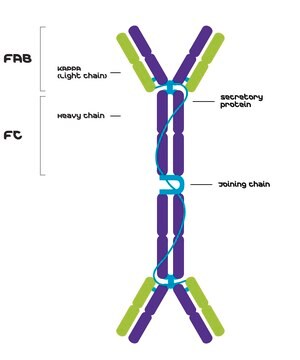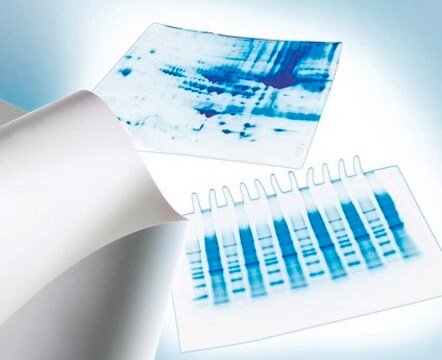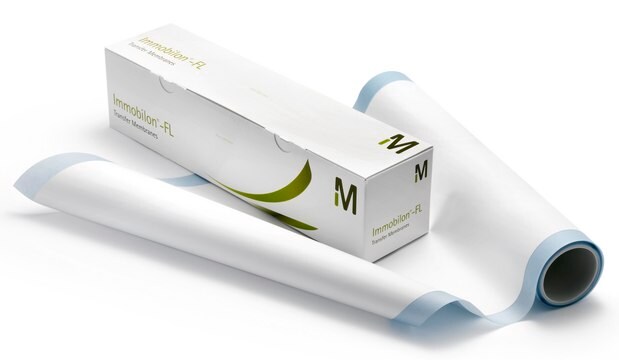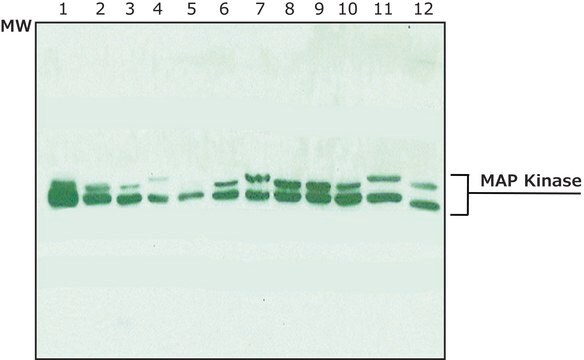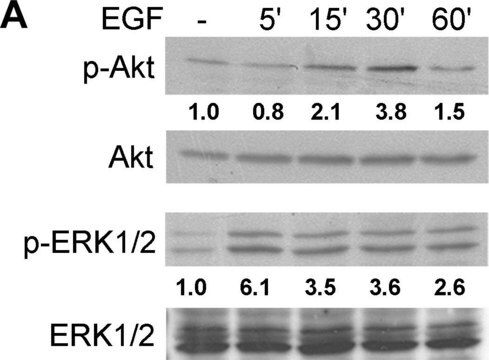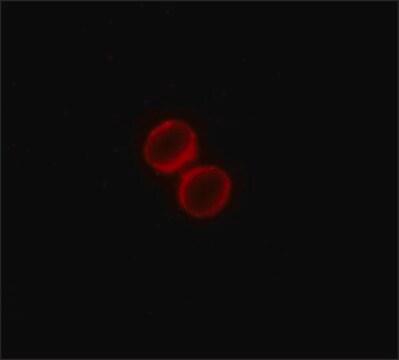MABF2084
Anti-Phosphorylcholine Antibody, clone BH8
clone BH8, from mouse
Synonym(s):
PC, ChoP
Sign Into View Organizational & Contract Pricing
All Photos(1)
About This Item
UNSPSC Code:
12352203
eCl@ss:
32160702
NACRES:
NA.41
Recommended Products
biological source
mouse
antibody form
purified immunoglobulin
antibody product type
primary antibodies
clone
BH8, monoclonal
species reactivity (predicted by homology)
all
technique(s)
ELISA: suitable
flow cytometry: suitable
immunocytochemistry: suitable
western blot: suitable
isotype
IgMκ
target post-translational modification
unmodified
General description
Phosphorylcholine (PC) is considered as an important immunodominant determinant of pneumococcal teichoic acids. It is found in the cell walls of a variety of pathogenic and nonpathogenic microorganisms, including Streptococcus pneumoniae, lactobacillus, certain fungi, and nematodes. PC plays an important protective role in pneumococcal bacterial infection. It is also a major prerequisite for proinflammatory effects of PAF and PAF-like lipids.Antibodies to PC are naturally present in humans and their levels are reported to decline with age. Natural PC-specific antibodies are reported to constitute about 5 to 10% of the total IgM pool in humans. Antibodies to PC have been subdivided into two populations, Group I and II, based on their affinity for PC and p-nitrophenyl phosphorylcholine (NPPC). Group I anti-PCs bind both PC and NPCC whereas Group II require a phenyl group and bind only to NPPC. Anti-PC IgM, IgA, and IgG1 belong to the Group I and Anti-PC IgG2 is entirely made up of Group II antibodies. Anti-PC IgM has are reported to exhibit a negative correlation with atherosclerosis development in hypertensive individuals and low levels of anti-PC may be used to predict development of cardiovascular disease. (Ref.: Su, J., et al. (2006). Atherosclerosis. 188(1):160-166; Sjoberg, BG et al. (2009). Atherosclerosis. 203(2); 528-532).
Specificity
Clone BH8 speifically detects phosphocholine conjugated to BSA.
Immunogen
Bacteria (Streptococcus pneumoniae, non-encapsulated strain R36A).
Application
Anti-Phosphorylcholine, clone BH8, Cat. No. MABF2084, is a mouse monoclonal antibody that detects Phosphorylcholine and has been tested for use in ELISA, Flow Cytometry, Immunocytochemistry, Inhibition/Function studies, and Western Blotting.
ELISA Analysis: A representative lot detected Phosphorylcholine in ELISA applications (Patel, P.S., et. al. (2015). J. Immunol. 194(12):5838-50).
Inhibits Activity/Function Analysis: A representative lot inhibited lung-resident APC activation and diminished the infiltration of allergy-associated cells into the pulmonary parenchyma in mice. (Patel, P.S., et. al. (2015). J Immunol. 194(12):5838-50).
ELISA Analysis: A representative lot detected Phosphorylcholine in ELISA applications (Ansel, K.M., et. al. (2002). Immunity. 16(1):67-76).
Flow Cytometry Analysis: A representative lot detected Phosphorylcholine in Flow Cytometry applications (Patel, P.S., et. al. (2015). J. Immunol. 194(12):5838-50).
Immunocytochemistry Analysis: A representative lot detected Phosphorylcholine in Immunocytochemistry applications (Patel, P.S., et. al. (2015). J. Immunol. 194(12):5838-50).
Inhibits Activity/Function Analysis: A representative lot inhibited lung-resident APC activation and diminished the infiltration of allergy-associated cells into the pulmonary parenchyma in mice. (Patel, P.S., et. al. (2015). J Immunol. 194(12):5838-50).
ELISA Analysis: A representative lot detected Phosphorylcholine in ELISA applications (Ansel, K.M., et. al. (2002). Immunity. 16(1):67-76).
Flow Cytometry Analysis: A representative lot detected Phosphorylcholine in Flow Cytometry applications (Patel, P.S., et. al. (2015). J. Immunol. 194(12):5838-50).
Immunocytochemistry Analysis: A representative lot detected Phosphorylcholine in Immunocytochemistry applications (Patel, P.S., et. al. (2015). J. Immunol. 194(12):5838-50).
Research Category
Inflammation & Immunology
Inflammation & Immunology
Quality
Evaluated by Western Blotting in Phosphorylcholine-BSA conjugate.
Western Blotting Analysis: A 1:250 dilution of this antibody detected Phosphorylcholine-BSA conjugate.
Western Blotting Analysis: A 1:250 dilution of this antibody detected Phosphorylcholine-BSA conjugate.
Target description
~66 kDa observed. Uncharacterized bands may be observed in some lysate(s).
Physical form
Format: Purified
Purified mouse monoclonal antibody IgM in PBS without azide.
Storage and Stability
Stable for 1 year at -20°C from date of receipt. Handling Recommendations: Upon receipt and prior to removing the cap, centrifuge the vial and gently mix the solution. Aliquot into microcentrifuge tubes and store at -20°C. Avoid repeated freeze/thaw cycles, which may damage IgG and affect product performance.
Other Notes
Concentration: Please refer to lot specific datasheet.
Disclaimer
Unless otherwise stated in our catalog or other company documentation accompanying the product(s), our products are intended for research use only and are not to be used for any other purpose, which includes but is not limited to, unauthorized commercial uses, in vitro diagnostic uses, ex vivo or in vivo therapeutic uses or any type of consumption or application to humans or animals.
Not finding the right product?
Try our Product Selector Tool.
Certificates of Analysis (COA)
Search for Certificates of Analysis (COA) by entering the products Lot/Batch Number. Lot and Batch Numbers can be found on a product’s label following the words ‘Lot’ or ‘Batch’.
Already Own This Product?
Find documentation for the products that you have recently purchased in the Document Library.
Kevin B Weyant et al.
Nature communications, 14(1), 464-464 (2023-01-29)
Engineered outer membrane vesicles (OMVs) derived from Gram-negative bacteria are a promising technology for the creation of non-infectious, nanoparticle vaccines against diverse pathogens. However, antigen display on OMVs can be difficult to control and highly variable due to bottlenecks in
Our team of scientists has experience in all areas of research including Life Science, Material Science, Chemical Synthesis, Chromatography, Analytical and many others.
Contact Technical Service
